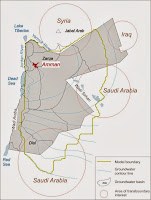Jordan’s Water Resources: Challenges for the Future
-- a _kt75 | reprint
close ✕
In 1987, The World Commission on Environment and Development (also known as the Brundtland Commission) warned in the final report „Our Common Future‟ that water was being polluted and water supplies were being overused in many parts of the world. Since this time there has been a dramatic increase in water use for food and energy production to meet the demands of a rapidly growing population and to enhance human wellbeing (WWAP, 2006). These demands for water continue to rise and there is increasing evidence of water scarcity in many parts of the world. This scarcity has the potential to adversely affect economic development, environmental quality, sustainable human activities and a limit the possibility of the achievement of a wide range of economic, environmental and societal objectives (UNEP, 2007). In addition, in many countries, particularly in the less developed world, there a rapid growth in the proportion of the population based in urban communities. This growth in urban populations places substantial pressures on water resources and the infrastructure to deliver fresh water to the population and to remove waste water. It is projected that 75 per cent of World population growth to 2015 will take place in cities, predominantly in the developing world (UNDP, 1998), and consequently the need to develop and maintain the infrastructure to deliver water efficiently and of the required quality to both established and new urban dwellers will place tremendous strain on existing facilities and require major investments in new facilities. In addition to requirements related to water provision there is a rapidly growing requirement to develop and maintain systems to remove wastewater and treat it before its return to the hydrological cycle. The nature and magnitude of these problems are highlighted in the United Nations Development Programme‟s Human Development Report (UNDP, 2006).
Water resources to meet these demands have been declining for a number of years and continue to do so as a result of excessive withdrawal of surface- and groundwater, as well as decreased water run off due to reduced precipitation and increased evaporation attributed to global warming (UNEP, 2007). In many parts of the world (for example West Asia and the Indo-Gangetic Plain in South Asia) human consumption of water exceeds annual replenishment. It is anticipated that by 2025 almost one fifth of the global population will be living in countries or regions with absolute water scarcity and two third of the population will be living under conditions of water stress (UNWater, 2007). Jordan in the Middle East and North Africa region provides an excellent example of a water poor country which has seen rapidly changing demands on water resources in recent years. The case of Jordan highlights the need to manage water resources carefully; this will involve setting clear programmes for identifying priorities for water use.

